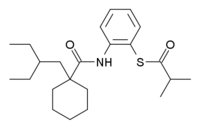
CETP inhibitor
Encyclopedia


Cholesterylester transfer protein
Cholesteryl ester transfer protein , also called plasma lipid transfer protein, is a plasma protein that facilitates the transport of cholesteryl esters and triglycerides between the lipoproteins...
(CETP). They are intended to reduce the risk of atherosclerosis
Atherosclerosis
Atherosclerosis is a condition in which an artery wall thickens as a result of the accumulation of fatty materials such as cholesterol...
(a cardiovascular disease
Cardiovascular disease
Heart disease or cardiovascular disease are the class of diseases that involve the heart or blood vessels . While the term technically refers to any disease that affects the cardiovascular system , it is usually used to refer to those related to atherosclerosis...
) by improving blood lipid levels.
Examples include:
- TorcetrapibTorcetrapibTorcetrapib was a drug being developed to treat hypercholesterolemia and prevent cardiovascular disease...
, failed in 2006 - excess deaths in phase III. - AnacetrapibAnacetrapibAnacetrapib is a CETP inhibitor being developed to treat hypercholesterolemia and prevent cardiovascular disease.-Clinical trials:...
, encouraging phase IIb interim results in 2010. Runs till 2012. - Dalcetrapib (JTT-705) In phase II in 2010.
Mechanism
CETP inhibitors inhibit cholesteryl ester transfer protein (CETP), which normally transfers cholesterol from HDL cholesterolHigh density lipoprotein
High-density lipoprotein is one of the five major groups of lipoproteins, which, in order of sizes, largest to smallest, are chylomicrons, VLDL, IDL, LDL, and HDL, which enable lipids like cholesterol and triglycerides to be transported within the water-based bloodstream...
to very low density
Very low density lipoprotein
Very-low-density lipoprotein is a type of lipoprotein made by the liver. VLDL is one of the five major groups of lipoproteins that enable fats and cholesterol to move within the water-based solution of the bloodstream...
or low density lipoprotein
Low density lipoprotein
Low-density lipoprotein is one of the five major groups of lipoproteins, which in order of size, largest to smallest, are chylomicrons, VLDL, IDL, LDL, and HDL, that enable transport of cholesterol within the water-based bloodstream...
s (VLDL or LDL). Inhibition of this process results in higher HDL levels (the "good" cholesterol-containing particle) and reduces LDL levels (the "bad" cholesterol).

